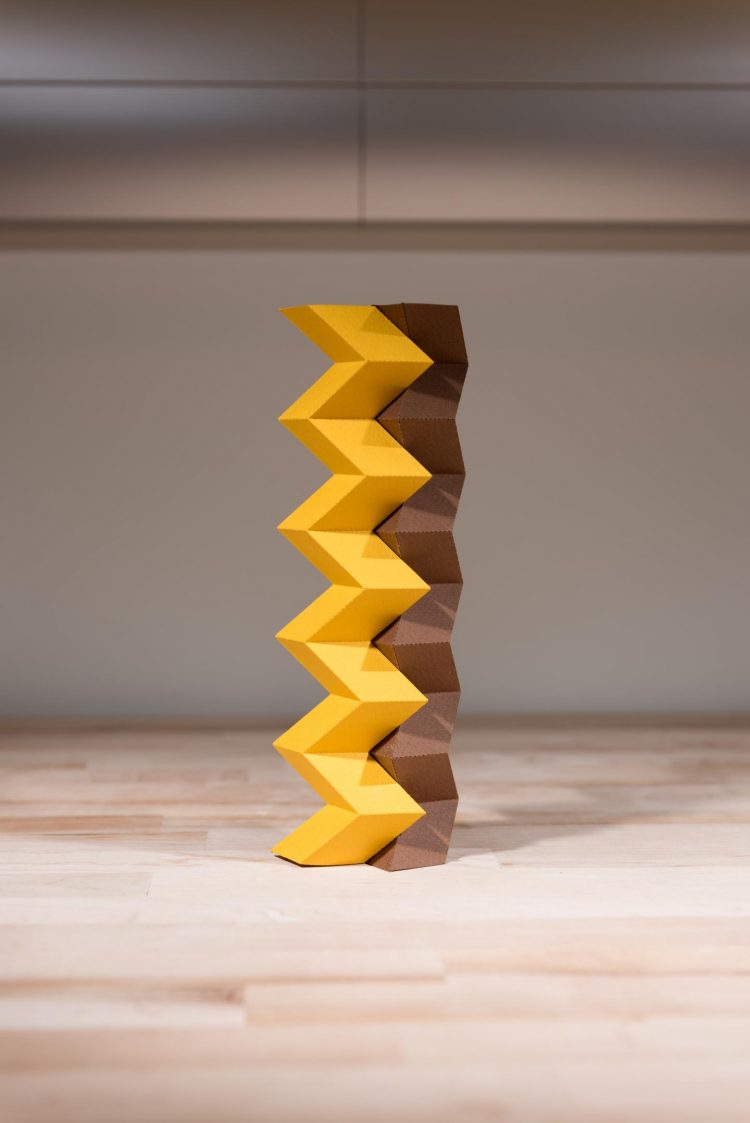Paper tubes make stiff origami structures

Origami 'zipper tubes' interlocking zigzag paper tubes, can be configured to build a variety of structures that have stiffness and function, but can fold compactly for storage or shipping. Credit: Rob Felt
Researchers from the University of Illinois at Urbana-Champaign, the Georgia Institute of Technology and the University of Tokyo have developed a new “zippered tube” configuration that makes paper structures that are stiff enough to hold weight yet can fold flat for easy shipping and storage.
Their method could be applied to other thin materials, such as plastic or metal, to transform structures from furniture to buildings to microscopic robots.
Illinois graduate researcher Evgueni Filipov, Georgia Tech professor Glaucio Paulino and University of Tokyo professor Tomohiro Tachi published their work in the Proceedings of the National Academy of Sciences.
Origami structures would be useful in many engineering and everyday applications, such as a robotic arm that could reach out and scrunch up, a construction crane that could fold to pick up or deliver a load, or pop-up furniture. Paulino sees particular potential for quick-assembling emergency shelters, bridges and other infrastructure in the wake of a natural disaster.
“Origami became more of an objective for engineering and a science just in the last five years or so,” Filipov said. “A lot of it was driven by space exploration, to be able to launch structures compactly and deploy them in space. But we're starting to see how it has potential for a lot of different fields of engineering. You could prefabricate something in a factory, ship it compactly and deploy it on site.”
The researchers use a particular origami technique called Miura-ori folding. They make precise, zigzag-folded strips of paper, then glue two strips together to make a tube. While the single strip of paper is highly flexible, the tube is stiffer and does not fold in as many directions.
The researchers tried coupling tubes in different configurations to see if that added to the structural stiffness of the paper structures. They found that interlocking two tubes in zipper-like fashion made them much stiffer and harder to twist or bend. The structure folds up flat, yet rapidly and easily expands to the rigid tube configuration.
“The geometry really plays a role,” said Paulino, a former Illinois professor of civil and environmental engineering. “We are putting two tubes together in a strange way. What we want is a structure that is flexible and stiff at the same time. This is just paper, but it has tremendous stiffness.”
The zipper configuration works even with tubes that have different angles of folding. By combining tubes with different geometries, the researchers can make many different three-dimensional structures, such as a bridge, a canopy or a tower.
“The ability to change functionality in real time is a real advantage in origami,” Filipov said. “By having these transformable structures, you can change their functionality and make them adaptable. They are reconfigurable. You can change the material characteristics: You can make them stiffer or softer depending on the intended use.”
The team uses paper prototypes to demonstrate how a thin, flexible sheet can be folded into functional structures, but their techniques could be applied to other thin materials, Filipov said. Larger-scale applications could combine metal or plastic panels with hinges.
Next, the researchers plan to explore new combinations of tubes with different folding angles to build new structures. They also hope to apply their techniques to other materials and explore applications from large-scale construction to microscopic structures for biomedical devices or robotics.
“All of these ideas apply from the nanoscale and microscale up to large scales and even structures that NASA would deploy into space,” Paulino said. “Depending on your interest, the applications are endless. We have just scratched the surface. Once you have a powerful concept, which we think the zipper coupling is, you can explore applications in many different areas.”
###
The National Science Foundation supported this work.
Editor's notes: To reach Evgueni Filipov, email filipov1@illinois.edu. To reach Glaucio Paulino, call 217-333-3233; email: glaucio.paulino@ce.gatech.edu. The paper “Origami tubes assembled into stiff, yet reconfigurable structures and metamaterials” is available from PNAS.
Media contacts:
University of Illinois: Liz Ahlberg, 217-244-1073, eahlberg@illinois.edu
Georgia Tech: John Toon, john.toon@comm.gatech.edu
University of Tokyo: Hiroaki Ishino, koho-jyoho@adm.c.u-tokyo.ac.jp
Media Contact
All latest news from the category: Materials Sciences
Materials management deals with the research, development, manufacturing and processing of raw and industrial materials. Key aspects here are biological and medical issues, which play an increasingly important role in this field.
innovations-report offers in-depth articles related to the development and application of materials and the structure and properties of new materials.
Newest articles

Compact LCOS Microdisplay with Fast CMOS Backplane
…for High-Speed Light Modulation. Researchers from the Fraunhofer Institute for Photonic Microsystems IPMS, in collaboration with HOLOEYE Photonics AG, have developed a compact LCOS microdisplay with high refresh rates that…

New perspectives for material detection
CRC MARIE enters third funding period: A major success for terahertz research: Scientists at the University of Duisburg-Essen and the Ruhr University Bochum have been researching mobile material detection since…

CD Laboratory at TU Graz Researches New Semiconductor Materials
Using energy- and resource-saving methods, a research team at the Institute of Inorganic Chemistry at TU Graz aims to produce high-quality doped silicon layers for the electronics and solar industries….



